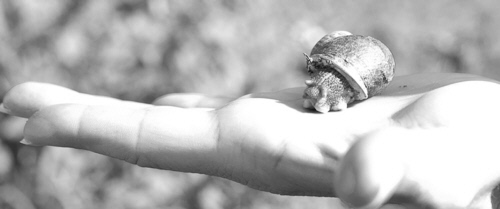The farm of the Pilloni family is located in the hinterland of Sardinia near the village Gonnosfadiga. After having passed a very uneven gravel road and circumventing lots of big potholes, we arrived at their farm. There, Luigi Pilloni aided by his wife and daughter, is raising snails whose scientific name is Helix aspersa which is the most widespread snail species around the Mediterranean.
The farm was partitioned in rectangular fields, one adjacent to the other one. Actually, the owner had divided the snail farm in one part where the snails could lay eggs and where young snails could grow, while another part was covered with nets in order to protect the snail against birds.
In the first area the female snails lay eggs below ground. After hatching, the snails start to feed on the vegetables which have been planted in the field. The vegetables which are used to feed the snails in this phase are various types of chicory and cabbage, both of which contribute to hardening the shell. In fact, they are rich in calcium, an element which is used by the snails to grow and harden their shells. They are also fed watermelons and squash for the same reason.
Growing a resistant shell is a characteristic of the major part of molluscs, being invertebrate animals, need to create a protective shell which they use to defend themselves from external dangers, like predators, to avoid injuries, but also as a refuge against harsh weather, in particular the sun by keeping themselves humid in order to avoid drying out. Since the snails become lethargic in winter and disappear before reappearing in spring, it is possible to see the various phases of the growth of the shell, with clear transitions between the parts that form the typical spiral.
Luigi started raising snails 9-10 years ago, but in fact, it was his wife who made him start doing it.
All the plants used for feeding the snails are grown organically and no pesticides are used. However, he has disinfected the plants against parasites since this is allowed in organic farming.
In general, a year is required from the eggs are laid till the adult snails can be sold depending on their diet and the weather. While cold weather makes the snails lethargic, warm weather limits their growth. Harvesting the snails is done manually in May.
The snails are above all sold in the village where they live because they are much appreciated by the locals.
Regarding cooking of the snails, the wife of Luigi kindly explained to us that first you have to flush out the slime of the snails. Add salt to boiling water and pour the snails into the water. The salt will expel the slime of the snails and then they can be cooked as one wants.
A simple recipe is to cook them in an oven and serve them with a type of sauce, tomatoes, garlic and chili.
In addition to raising snails, the Pilloni family are also raising various races of chicken and they are cultivating vegetables.

